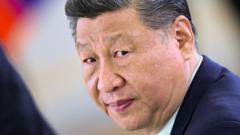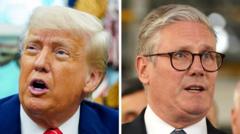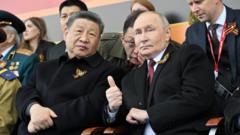In a notable shift, President Trump hinted at a readiness to significantly lower tariffs on Chinese goods from 145 percent to 80 percent ahead of critical trade discussions with China, potentially influencing international economic relations.
Trump Signals Willingness to Reduce Tariffs in Upcoming China Trade Talks

Trump Signals Willingness to Reduce Tariffs in Upcoming China Trade Talks
President Trump's potential plan to cut tariffs on Chinese imports raises economic stakes in high-stakes negotiations.
The article discusses President Trump's recent statements regarding tariffs on Chinese imports as negotiators prepare for high-level talks in Switzerland. In a post on social media, Trump suggested that a reduction to 80 percent seems appropriate, indicating a willingness to ease the current 145 percent tariffs he previously imposed. This proposal comes as China and the U.S. aim to address ongoing trade tensions that have unsettled global markets.
The negotiations scheduled for the weekend are pivotal for seeking a broader trade agreement and might ease existing trade conflicts. Treasury Secretary Scott Bessent, alluded to in Trump's post, has characterized the existing tariffs as “unsustainable” and has advocated for dialogue focused on perceived unfair trade practices that the U.S. faces. While Trump’s historical stance has leaned towards protectionism, he has also advocated for an open market system, urging China to improve access for American businesses. This evolving stance reflects the complex dynamics of U.S.-China trade relations as both sides seek resolution amidst economic pressures.
The negotiations scheduled for the weekend are pivotal for seeking a broader trade agreement and might ease existing trade conflicts. Treasury Secretary Scott Bessent, alluded to in Trump's post, has characterized the existing tariffs as “unsustainable” and has advocated for dialogue focused on perceived unfair trade practices that the U.S. faces. While Trump’s historical stance has leaned towards protectionism, he has also advocated for an open market system, urging China to improve access for American businesses. This evolving stance reflects the complex dynamics of U.S.-China trade relations as both sides seek resolution amidst economic pressures.




















